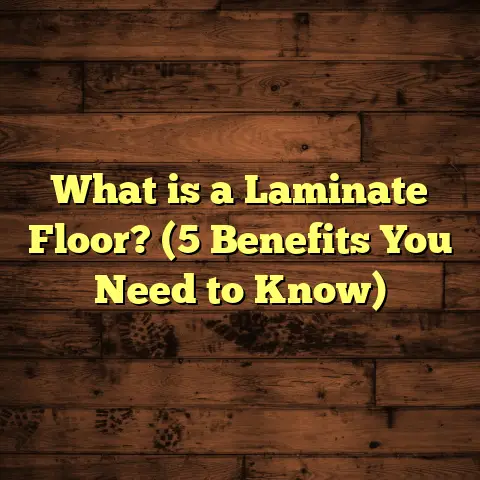What is Free Floating Flooring? (5 Must-Know Benefits for Homeowners)
Sometimes, when a client calls me up panicked about their worn-out or damaged floor, I don’t always have to suggest ripping everything out and starting fresh. Often, the best quick fix or smart long-term solution is free floating flooring. If you’re curious about this type of flooring—what it really means, how it works, and why it might be perfect for your home—I’m here to walk you through everything you need to know.
I’ve been installing floors for over 15 years now. In that time, I’ve worked with countless materials and installation methods, but free floating floors have steadily grown in popularity. Why? Because they combine ease, durability, and style in a way that suits many homeowners’ needs.
What is Free Floating Flooring?
Free floating flooring is a method of floor installation where the floorboards aren’t attached directly to the subfloor beneath. Instead, the planks or tiles are fastened to each other, usually with a click-lock or tongue-and-groove mechanism, and simply rest on top of an underlayment.
This means the entire floor “floats” over the surface below rather than being nailed or glued down. The floor can expand and contract slightly with temperature and humidity changes because it isn’t fixed in place.
How Does It Work?
Think of it like a giant puzzle laid over your existing floor. Each plank snaps into the next without needing adhesives or nails. Beneath the floating floor lies a thin underlayment—often foam or cork—which cushions the floor, provides moisture protection, and reduces noise transfer.
The underlayment thickness usually ranges from 1mm to 3mm but can be thicker for soundproofing or insulation purposes.
Where Can You Install Free Floating Floors?
You can install floating floors over many types of subfloors:
- Concrete slabs: Ideal for basements or ground-level rooms.
- Plywood or OSB subfloors: Common in upstairs rooms and older homes.
- Existing tile floors: Saves demolition time and cost.
- Radiant heating systems: Some floating floors work well over heated subfloors (check manufacturer specs).
This flexibility makes them attractive for both renovations and new builds.
What Materials Use Free Floating Installation?
Not all flooring materials can float, but these ones commonly do:
- Laminate Flooring: Made of fiberboard core with a photographic image layer that mimics wood or stone.
- Vinyl Plank Flooring (LVP): Waterproof vinyl boards that look like hardwood or tile.
- Engineered Hardwood: Real wood veneer over plywood layers, designed for floating installs.
- Some Cork and Bamboo Floors: Engineered versions may also float.
Solid hardwood typically requires nailing or gluing down because of its thickness and expansion needs.
The Numbers Behind Free Floating Flooring
When planning any flooring project, numbers matter—costs, dimensions, timing—all these details help you make smart choices.
Standard Measurements
Floating flooring planks usually measure:
- Length: Around 48 inches (4 feet)
- Width: Between 5 inches and 7 inches
- Thickness: 6mm to 12mm (thicker boards tend to feel more solid underfoot)
These sizes allow for quick installation while maintaining durability.
Cost Breakdown
Here’s a rough idea of material costs per square foot:
| Material | Cost per Sq Ft (Material Only) |
|---|---|
| Laminate Flooring | $1.50 – $3 |
| Vinyl Plank Flooring | $2 – $5 |
| Engineered Hardwood | $3 – $7 |
| Cork/Bamboo (Floating) | $3 – $6 |
Labor costs vary but typically add $1.50 – $3 per square foot when hiring professionals.
For example, if you’re installing 1,000 sq ft of vinyl plank flooring at $4/sq ft material cost plus $2/sq ft labor, budget around $6,000 total.
Installation Timeframes
Because there’s no drying time for glue or nail-down prep, installation goes fast:
- Small rooms (100 – 300 sq ft): Usually done in under a day
- Medium rooms (300 – 800 sq ft): One to two days
- Large areas (800+ sq ft): Two to four days depending on complexity
When I did a 900 sq ft laminate floor job last year in Chicago, my team finished in just three days. That included removing baseboards and prepping doorways.
Five Must-Know Benefits for Homeowners
Let me share five reasons why I often recommend free floating floors to my clients.
1. Speedy Installation Saves Time and Money
One of the biggest perks is how quickly these floors go down. Since there’s no need to wait for adhesives to dry or nails to be hammered in precisely, you can walk on the floor right after installation.
I once helped a client in Seattle who urgently needed flooring before their family reunion weekend. We installed 700 sq ft of vinyl planks in two days — all done without fuss and with minimal mess.
2. Saves Budget Without Sacrificing Style
Free floating floors give you access to beautiful looks at lower prices. Laminate offers realistic wood grain finishes that cost a fraction of solid hardwood. Vinyl planks are waterproof and come in dozens of textures and colors.
One homeowner in Atlanta got a full kitchen and dining room upgrade with floating engineered hardwood for about $25 per square foot installed—a big saving compared to traditional hardwood installations that often hit $40+ per square foot.
3. Works Over Many Existing Surfaces
Renovations can be costly if you have to rip up old flooring first. With floating floors, you can often lay new planks right over existing tile or concrete slabs, saving time and money.
In Florida, I installed floating vinyl planks directly over old ceramic tile in a condo basement. The homeowners avoided demolition dust and saved thousands on prep work.
4. Handles Temperature and Humidity Changes Gracefully
Floors expand and contract with humidity changes—something solid hardwood floors nailed down can struggle with. Floating floors are designed to move slightly without buckling or gaps because they aren’t fixed rigidly.
This is why clients in humid climates like Louisiana find floating floors last longer with fewer issues like warping.
5. Easy Repairs and Replacement
If damage occurs—maybe your dog scratched a few planks or a heavy object fell—you can replace individual boards easily without pulling up the entire floor.
I remember replacing just four damaged laminate boards for a family in Texas after their toddler’s toy truck cracked some planks. The repair took under an hour and didn’t disrupt their day much.
A Few Stories From My Job Sites
There’s something special about seeing how free floating floors transform real homes.
Basement Makeover in Denver
One chilly winter, I worked on a basement remodel where the concrete slab was uneven and prone to moisture. Instead of expensive leveling compounds, we chose an engineered wood floating floor with a moisture barrier underlayment.
The result? A warm-looking floor that didn’t trap moisture or creak like some wood floors do over concrete. It took just three days from prep to finish across 900 square feet.
Kitchen Refresh in Austin
A couple wanted to update their kitchen but couldn’t afford a full tear-out. We installed luxury vinyl plank floating flooring over their original tile in a weekend. The boards looked like distressed hickory hardwood but stayed waterproof for spills and pet accidents.
They told me the next week it felt like walking on clouds—soft but sturdy underfoot.
Comparing Floating Flooring Materials
Choosing the right material is key for your lifestyle and budget.
| Material | Durability | Water Resistance | Maintenance | Price Range |
|---|---|---|---|---|
| Laminate | Moderate (scratches easily) | Low (not waterproof) | Requires quick spill cleanup | $1.50 – $3 / sq ft |
| Vinyl Plank | High (waterproof) | Excellent | Easy (mop + mild cleaner) | $2 – $5 / sq ft |
| Engineered Hardwood | High | Moderate (some water resistance) | Regular sweeping + occasional refinishing | $3 – $7 / sq ft |
| Cork | Moderate | Moderate | Requires sealing | $3 – $6 / sq ft |
Installation Tips From My Toolbox
If you’re thinking about installing floating flooring yourself—or want to supervise pros better—here are some tips I swear by:
- Prep Your Subfloor: Clean thoroughly and level any dips over 3/16 inch across 10 feet for best results.
- Use Quality Underlayment: It cushions your floor and reduces noise—a thin foam won’t cut it if noise control matters.
- Leave Expansion Gaps: Always leave 1/4 inch gaps around walls and fixed objects so the floor can move.
- Acclimate Your Flooring: Let planks sit in the installation room for at least 48 hours beforehand to adjust to temperature/humidity.
- Plan Your Layout: Start from the longest straight wall and stagger plank joints at least 6 inches apart for stability.
- Cut Carefully: Use a laminate cutter or fine-toothed saw to avoid splintering edges.
Maintenance Advice That Helps Floors Last
Free floating floors are low maintenance but some care keeps them looking fresh:
- Sweep or vacuum regularly to prevent grit scratching.
- Mop with a damp mop using manufacturer-recommended cleaners.
- Avoid soaking water—wipe spills quickly especially on laminate floors.
- Use furniture pads under legs to prevent dents.
- Reseal cork or engineered hardwood every few years as needed.
Common Issues & Troubleshooting
Even great floors hit bumps now and then:
- Buckling: Usually caused by not leaving enough expansion space; removing baseboards may help relieve pressure.
- Click-Lock Separating: Sometimes boards pull apart if not clicked firmly; disassemble and re-click carefully.
- Squeaking: Often from uneven subfloors; adding an underlayment with soundproofing properties can reduce noise.
I’ve learned these fixes through hands-on experience on dozens of sites.
Final Thoughts: Should You Choose Free Floating Flooring?
If you want an affordable, stylish floor that installs quickly with less mess—and one that’s easier on your back during installation—free floating flooring is worth serious thought.
It suits homeowners who want durable options over concrete slabs or existing floors without major demolition. Plus, it’s popular among DIYers for those same reasons.
If you’re not sure which material fits your lifestyle best or want help budgeting your project based on your home size and location, just ask me. I’ve helped hundreds of people figure out what fits their needs while keeping costs reasonable.
If you want me to help calculate costs based on your exact room size or offer recommendations tailored to your climate zone or home style, just say so! I’m happy to share more insights from my years working hands-on with these floors across the country.
What’s your next project look like? Are you thinking about updating one room or doing a full home refresh?





